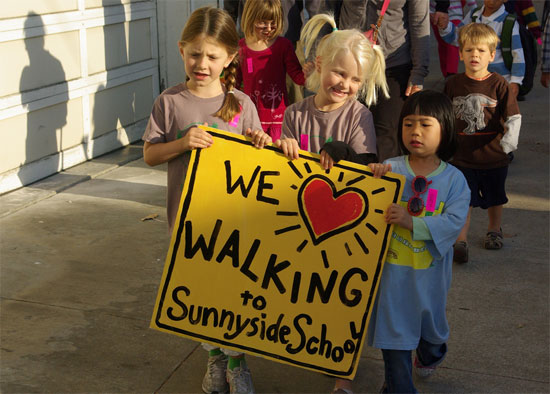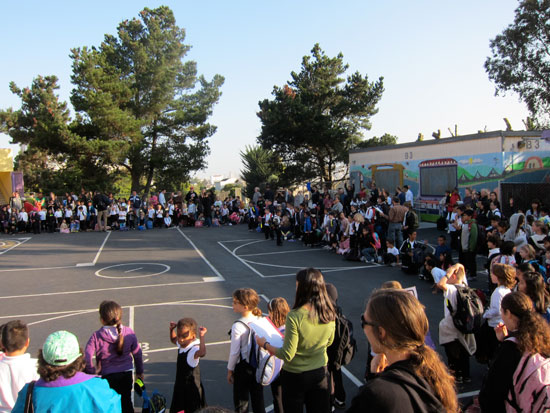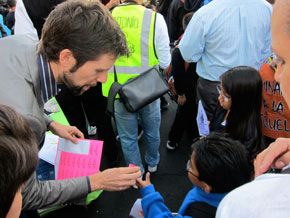Promoting Health and Physical Activity Among Children on Walk to School Day
2:12 PM PDT on October 7, 2010

With childhood obesity a growing national epidemic, it is surprising that more parents don't walk to school with their kids or organize amongst neighbors to encourage physical activity as part of the daily routine. Though San Francisco has extensive public transit and is quite walkable, the current school assignment policy results in longer school commutes, a problem city officials and advocates for increased walking blame in part for children not getting enough daily exercise.
Coinciding with yesterday's International Walk to School Day, the San Francisco Unified School District (SFUSD) and the Department of Public Health (SFDPH) discussed a study they have undertaken to collect baseline data on school commute patterns in an effort to encourage more walking. This initiative is especially important now, say officials, because the city will change the way it assigns children to schools starting in fall 2011 and they will have the opportunity to measure the impact local assignments will have on travel choice.
Officials plan to collect data at the fifteen schools participating in the Safe Routes to School program, as well as others that are not, and they hope the resulting information will demonstrate how effective improved traffic engineering, enforcement and eduction can be.
Ana Validzic, a SFDPH pedestrian safety coordinator, was at Fairmount Elementary School in Noe Valley yesterday to raise awareness for Walk to School Day. Fairmount and nine other schools were added to the city's Safe Routes to School (SRTS) program this year, in addition to the five from last year. These schools are at the top of the city's priority list for traffic calming treatments and better enforcement of traffic safety violations.
"One of the biggest obstacles right now is the way students are assigned to their schools," said Validzic. With the change in the SFUSD assignment policy, she said, children will live much closer to their schools and parents won't have as much of an impetus to drive. "It's going to make programs like Safe Routes to School much more realistic."

Validzic cobbled together $15,000 in funding for the baseline study, which will be coordinated with the University of California San Francisco and the SFUSD. The researchers will document commute patterns among students in kindergarten and 5th grade throughout the district, comparing the 15 schools in the Safe Routes to School (SRTS) program with non-SRTS schools to see which aspects of the program are the most effective (the five E's are education, encouragement, engineering, enforcement, and evaluation).
"We're trying to see if a switch to more neighborhood focused schools also leads to changes in commute behavior," said Nick Kaestner, SFUSD Director of Sustainability. "If it does in fact do that, that would be a big plus in terms of walking and biking."
Validzic said SFDPH and SFUSD are limited by current funding, but they hoped to find additional money over the next decade to enhance the study to include factors like student body mass index before and after the assignment policy change, which would allow them to more precisely measure the link between traffic engineering changes, safety, enforcement and physical activity. Given the impending assignment policy change, Validzic believes an expanded study would be the only one of its kind in the country and the data would prove vitally important to public health and transportation officials trying to combat obesity.
For Elizabeth Stampe, the new executive director of the pedestrian advocacy non-profit Walk San Francisco, educating and encouraging parents to walk their kids to school is a vital component for improving pedestrian safety citywide and compelling the political class to make streets safer.
"It's not safe to keep our kids from walking, because of the growing problem in our country of obesity," said Stampe, who noted her disappointment that San Francisco Mayor Gavin Newsom was inagurating a cruise ship, rather than participating in Walk to School Day. "I wish he would come out with us to see the conditions kids have to face when walking to school and make needed changes right away."
To draw attention to those dangers, Walk SF has partnered with The Friends of Monterey Boulevard, a community group comprised in part with parents whose children attend SRTS affiliated Sunnyside Elementary School, to prepare a report on the dangerous conditions on the street. The groups will present the report to the city soon and hope to work to realize numerous solutions to lower traffic speeds and improve visibility for pedestrians in the area.

Back at Fairmount Elementary, District 8 Supervisor Bevan Dufty, spoke to a restless gathering of students still excited from the group walk, or "human school bus," they formed a few blocks away on Dolores Street and San Jose Avenue, before proceeding to school.
Dufty told Streetsblog he was encouraged by the number of parents walking their kids to school, but he said the city needed to do more to improve safety.
"To be a great city, we have to have great schools and to have great schools, kids have to be safe and able to walk to school," he said. "Our children, our future, cross the streets and walk down the street every day getting to school and we need to be mindful of them."
Among other solutions, he argued Muni service had to be better and crosswalk visibility needed to be improved. San Francisco, he said, must "draw attention to the fact that motorists need to be aware that there are pedestrians, and not just pedestrians, but children coming to school."
Addressing the Fairmount students, Gaby Marin, the school's "Mother of the Year," asked other parents to follow her lead and commit to walking their children to school more often.
"A great way to start your day is to get up and walk to school," said Marin (author's translation from Spanish). "These twenty minutes of walking each day allow us to share ideas, to talk about what the day will be like. For my family, it's very important part of our day. I want to encourage you all, at least once a week, to walk to school. Leave the car, take public transport, and walk to school, even if it's only 20 minutes once a week."
Jeremy Hilinski, Fairmount's principal, said he was proud of the way parents had organized themselves for Walk to School Day, but he pointed to San Jose Avenue as a significant impediments to more walking. "Many of our families live on the other side of San Jose Avenue," he said, praising the crossing guard who works the intersection of San Jose and Randall each morning.
Hilinski saw promise in encouraging parents to work together informally to promote more walking. "I hope it gets bigger and bigger and bigger, that we have more people walking to school, critical masses of people walking from similar neighborhoods, crossing the streets together, getting out there and walking, as opposed to parking and driving and creatomg traffic congestion, things that create dangerous conditions around schools."
SFUSD's Kaestner said Fairmount could look to other SRTS schools, like Longfellow Elementary, where last year's Walk to School day inspired some parents to organize regular Walk to School Wednesdays. "In the short term, we have to rely on parents with some gentle prodding to make this happen, because we're not going to get the infrastructure changes we need in that time frame," he said.
"Longer term, of course, we hope the city of San Francisco will prioritize some of the changes in the streetscape that are around schools first, because those are the changes that will make a difference in students' commuting habits and that will change the way they lead the rest of their lives," he added.
Stay in touch
Sign up for our free newsletter
More from Streetsblog San Francisco
Commentary: Make Bay Area Transit Seamless as Condition of New Funding
SFMTA Starts West Portal Outreach
Agency presents plans to block traffic from crossing in front of the train station




